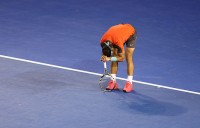Melbourne VIC, Australia, 19 August 2014 | Paul Fein, Australian Tennis Magazine
>1 Warm up
Warm up properly. If you skip or shortchange the warm-up, you risk injury and will likely get off to a poor start. Four-time Australian Open champion Novak Djokovic starts with 10 to 15 minutes of movement before every practice, workout, and match. In his new book, Serve to Win, Djokovic recommends: “Do five minutes of light jogging or stationary cycling to ease your body into activity and raise your heart rate. Then go right into these dynamic stretching exercises. Do ten reps of each without resting.” The necessary nine exercises are jumping jacks, walking high knees, squat thrusts, lunge with side bend, reverse lunge with backward reach, low side-to-side lunge, inverted hamstring, and inchworm.
“Recovery is the ultimate goal” after you practice or compete, stresses the resilient Djokovic. “So I get some level of massage almost every day to help my muscles recover and my body to process the toxins that build up during a long match or practice session.” If you can’t afford a regular professional massage, consider a low-cost (about $20) foam roller, which is available in any sporting goods shop. “You ‘foam roll’ by rolling different parts of your body over the tube, in effect giving yourself a massage,” Djokovic explains. Foam rolling improves your flexibility and movement and helps your muscles function properly. You don’t have to work on your flexibility two hours every day like the super-elastic Serb, but smarter warm-ups and recoveries will rev you up and keep you healthy.
>2 Keep moving
Remember to “split step” just before your opponent’s racquet contacts the ball. A body in motion tends to stay in motion (paraphrasing Newton’s First Law of Motion), and tennis players must stay in motion while the ball is in play.
Very few recreational players and only some junior competitors “split step” regularly. In sharp contrast, nearly every pro takes a small hop that enables them to regain balance and – depending on their shot and their opponent’s likely coming shot – then either sprint or cruise for a groundstroke or glide or lunge for a volley.
David Ferrer, Steffi Graf, and Justine Henin resemble dynamic boxers, most notably Manny Pacquiao, Amir Kahn, and Floyd Mayweather, always poised to punch or evade a punch. Dustin Pedroia, the two-time Golden Glove second baseman for the Boston Red Sox, revealed he hops just as the pitcher releases the ball to be well-prepared for any ball near him because he learned the skill from playing tennis.
Besides improving your footwork, court coverage, and shots, the “split step” will enhance your fitness.
>3 Defence is key
Improve your defence. When Andy Murray was asked on the Charlie Rose program about the difference between Djokovic, Roger Federer, Rafael Nadal, himself and the other pro players, he noted their defence. “The skills those players have when they’re defending and in difficult situations is incredible,” Murray said. “That’s really the difference because everyone hits the ball great. A lot of guys can play really good offense and can hit huge shots now. There are a lot of really big guys, from 6’6″ (198 cm) to 6’10” (208 cm), on the tour. But the ability to defend and come up with [excellent] shots on the run and in difficult situations makes the difference.”
So watch these defensive wizards, along with Agnieszka Radwanska and rising star Simona Halep, track down and return powerful shots. Then practice your defensive skills because they will help you reduce your forced errors and get you back into the point. Regardless of your physique and natural ability, you can improve defensively. As former world No.1 Lindsay Davenport pointed out, “Improved scrambling and defence have been so important in Maria Sharapova’s success on clay the last two years.”
>4 Go deep or go home
“The biggest difference between the top pros and the average pros is that the top pros hit deeper,” all-time great Martina Navratilova averred. When your shots land deep, you can elicit errors and weak returns, and you also make it much tougher for your opponent to attack you. The same theory and practice holds true in basketball, soccer, and ice hockey. Keep your opponents away from the basket and the goal, and it’s harder for them to score. Observe how Djokovic, Sharapova and Victoria Azarenka stay on the offense with superb depth. Also notice how Nadal’s performance often hinges on whether his heavy topspin forehand and slice backhand penetrate with depth or tentatively fall short.
> Improve your ground strokes with former pro Scott Draper
>5 Make your weakness your strength
Eliminate, or at least improve, any stroke weaknesses you have. Otherwise, you will make unforced errors, and opponents will attack your weaknesses.
“I don’t believe that anybody can equal everything on the court that Djokovic does. I don’t think you can find a weakness in his game,” noted coach Nick Bollettieri told The New York Times, adding that Djokovic is “perhaps” the most complete player he’s seen in six decades of tennis.
No wonder Djokovic exudes confidence even when he falls behind. He believes his superior technique will prevail sooner or later. Pay special attention to TV analysts as they discuss tactics players use to exploit their foes’ weaknesses.
>6 Find your centre
Watch how pros quickly regain their court position in terms of hugging the baseline and returning to “the centre of possible returns.” Federer and 1990s superstar Pete Sampras regroup fast so they have the best possible chance to attack with a groundstroke and perhaps also get to the net. Similarly, Li Na, Serena Williams, and Djokovic know the better their position, the better they can sustain or resume their aggressive baseline shotmaking.
Federer’s Baryshnikov-like movement comes not only from his innate athleticism but also unique footwork, according to Australian Open 2003 finalist Rainer Schuettler, now a coach. “Ten years ago when you ran to the corner to hit a forehand, you did a side step back to change direction and recover your position,” Schuettler explained. “Roger doesn’t do this. Roger normally makes a crossover step. As a result, he is two steps faster, going back to the middle.”
>7 Apply pressure
Observe how Grand Slam champions, such as Serena, Nadal, and Djokovic, pressure opponents as much as possible. “Any time I speak to tennis students, or any athletes, for that matter, I always talk about the same thing,” said highly respected TV analyst Mary Carillo.
“In any sport, the objective is to put the opponent in a state of emergency. Rob the other side of time – whether by taking the ball sooner, moving quicker, hitting harder or deeper, establishing a better beachhead from which to attack and defend. Do all that you can to force the other side to be hurried and harried, reactive instead of dominant.”
Tennis has its sinners and winners here. Richard Gasquet can’t rush anyone from 10 feet behind the baseline, and neither can the passive, medium-speed groundstrokes hit by Caroline Wozniacki. Not surprisingly, both Gasquet and Wozniacki struggle to stay inside the top 10. In sharp contrast, Serena fires her weapons from the first shot of every point: either her booming serve or her powerful serve return – and seldom lets up. As Carillo noted, “Serena’s return game is every bit as scary [explosive] as her serve game.”
>8 Stay focused
Don’t take any time off from either your concentration or your effort. You will pay a big price if you do, as even the doughty Djokovic found out in the 2013 Rome quarterfinals. He served for the match against Tomas Berdych at 6-2 5-3, but committed three uncharacteristic forehand errors and eventually bowed 2-6 7-5 6-4. “I lost concentration and started to play more defensively,” Djokovic lamented.
Nadal, Ferrer, Serena, and Sharapova are the ultimate warriors of this generation, while Jimmy Connors, Bjorn Borg, Monica Seles, and Steffi Graf were diehard competitors before them. After Nadal defeated arch-rival Djokovic 6-2 3-6 6-4 6-1 in the 2013 US Open final, CBS analyst John McEnroe raved, “This guy battles harder than anyone we’ve ever seen on a tennis court – there’s no doubt about that.” Former world No.1 Jim Courier said, “I’ve never seen Nadal beat himself in a tennis match – not once. It has to be taken from him.”
Can you say that about yourself?






